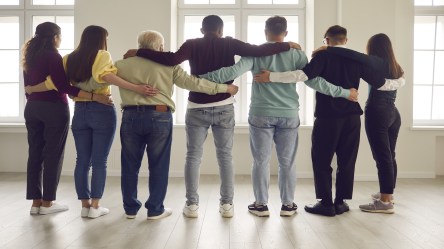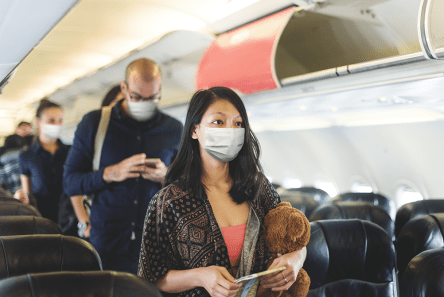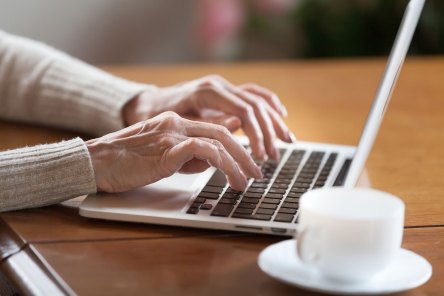“This telework phenomenon has shown people that they don’t have to be in the office all the time,” notes Tim Lomax, research fellow at the Texas A&M Transportation Institute. That realization has prompted many people to rethink options for getting to work – or if it’s necessary at all. Is a physical presence at work necessary, and if so, can commuting be made easier, more pleasant and environmentally conscious? “Tele” might be a permanent prefix for a long time. A survey of Californians released by the University of Southern California in April, for example, reported that more than half of telecommuting workers want to keep working from home at least three days a week after the pandemic ends. Just 18% wanted to go back to in-person work every day, while 31% said they would be happy working from home five days a week. Some businesses, seeing no harm to their profitability from remote work, might allow telecommuting as a full-time option. Looking at it from the employer’s point of view, about 30% of respondents to a poll of more than 300 North American employers by global advisory firm Willis Towers Watson said they expect about 30% of their full-time employees to work from home in three years, up from 5% three years ago. “Lots of [workers] want something in between their Zoom-based present — which has tested work-life boundaries and left many feeling isolated from their colleagues — and a full return to daily commuting that drained our time, energy and wallets,” says Nico Savidge, reporting in the Marin Independent Journal. But Lilac Nachum, a professor of international business at Baruch College, says that knowledge and innovation-based industries have the least to gain from working from home permanently because a significant amount of creativity,...
Yardi EHR
Enables Vaccine Tracking
With COVID-19 vaccines readily available across the nation — and with vaccine mandates becoming more common — senior living providers have an important job to do. They’re tasked with helping residents receive vaccinations, offering resources and lending support. But how can providers manage the process? Monitor symptoms? Track vaccination statuses? It’s all possible thanks to the latest upgrades in Yardi’s electronic health record solution. Tracking vaccinations with Yardi EHR Yardi EHR is a full-service solution that helps providers deliver the best resident care. And with the ongoing pandemic, the newest functionality in managing resident vaccinations may be most helpful for today’s providers. With the system’s latest infection surveillance and immunization dashboard, providers and senior care staff can document essential information relating to COVID-19 and other diseases. More specifically, staff can … Document if a resident has received, declined or missed COVID-19 vaccination appointmentsCollectively schedule vaccination appointments and track follow up assessments for community-wide vaccine clinicsBulk chart vaccine administration during clinicsLog information on a resident’s side effects post-vaccineIdentify residents who show symptoms consistent with COVID-19Send alerts to the dashboard when COVID-19 symptoms are documentedRecord when residents receive booster shots for their COVID-19 vaccineAdd indicators for other infectious diseases — all populated to the dashboard in real-time Best of all, the assessments are built-in and easy to navigate. Each assessment incorporates Centers for Disease Control and Prevention (CDC) guidelines for administering COVID-19 vaccines. If you’re an existing Yardi EHR client, adding the infection surveillance and immunization dashboard couldn’t be easier. The implementation and training process is quick — and efficient. This is especially beneficial for providers today, given the roll out of COVID-19 booster shots is around the corner. Senior living providers are navigating the pandemic day by day. And while there are many challenges, managing...
Suburban Demand
Prompts Lending Boom
Investors have set their sights on suburban and tertiary markets. Lenders are responding favorably to the trend. While banks will continue to keep one foot planted in major metros, many are following their trusted relationships to less familiar terrain outside of city limits. Sleepy secondary markets are waking up The shift began as a trend prompted by the pandemic but has continued at a steady clip through the highs and lows of COVID-19. This is particularly true in cities where major employers have transitioned to remote and hybrid models. Many white collar industries such as technology, consulting and legal have adapted more flexible work conditions. With zero or fewer days required for office attendance, employees have been exploring their housing options. Blake Hering, principal with Gantry Inc explains, “As these remote operating models adopted by many office users have taken root and grown following last year’s social distancing mandates, a generational shift valuing the lower cost of living, higher quality of life, and larger footprint domiciles available in secondary markets has clearly fueled the beginning of a new, robust cycle for regional markets outside the MSA domain.” Employees are venturing further from their workplace hubs to secondary and tertiary markets where their money likely goes farther: lesser-known markets may offer more square footage for their money and more outdoor space, housing trends that were revitalized during the pandemic. Lending follows the leader The migration is particularly evident in MSA markets such as Seattle, Wash., and Portland, Ore. in the Pacific Northwest. Investors are following demand to smaller markets such as Bend, Salem and Tacoma. “This shift is now rewarding experienced sponsors in what have become prioritized markets by offering access to a host of new lending sources that once only reserved their allocations for operators...
Public Transit
On the Move Again
What does the future hold for public transit – bus, light rail and subway – after the pandemic’s disruptions? Nationally, public transit ridership dropped by nearly 80% in April 2020 and remained more than 60% below 2019 levels through the rest of the year, with systems in San Francisco, Washington, D.C., Boston, Chicago, New York City, Seattle and Atlanta all losing more than half their ridership. “The fallout for public systems like transit has been nothing less than monumental,” says Government Technology, which covers information technology’s role in state and local governments. Public transit filled a vital need as COVID-19 raged, delivering workers to essential jobs at hospitals, pharmacies, grocery stores, fire and police stations and utility companies, and transporting medical patients, medicines, meals and critical supplies. Crews stepped up efforts to clean, disinfect and ventilate vehicles and facilities. Some agencies adopted new technology to better monitor system use during the pandemic and be more responsive to changing needs afterward. More recently, an infusion of federal emergency assistance has helped stabilize transit organization finances. Proposed infrastructure legislation includes several measures to expand bus routes and rail lines and convert gas and diesel vehicles to zero-emission electric vehicles. As of May, about 50% of transit riders nationwide had returned compared to pre-pandemic times, according to the American Public Transportation Assn. Roads & Bridges, a trade publication for the transportation construction and maintenance marketplace, notes that the pandemic “has elevated public awareness and appreciation for the vital role transit plays in our communities.” New challenges arise But even as the pandemic wanes in some regions, new challenges arise for public transit, which less than 6% of Americans used to commute to work before the pandemic. Work-from-home arrangements appear to be a durable trend with little or...
Sound Bites
Keeping Healthy Food Habits
Few effects of the pandemic were felt as immediately or universally as food consumption. Barren supermarket shelves, higher prices and social distancing edicts forced many consumers to develop new patterns for obtaining and preparing food. According to results from a Consumer Reports survey published in January, about 80% of Americans made at least one change in the food they eat or the way they source or prepare it. People were snacking, stress eating and eating comfort foods more often, with 32% admitting they’ve gained weight (and 15% claiming to lose some). Another 22% said they were eating healthier than they were a year ago. “When people have less structure in their day and more access to the kitchen, it leads to more snacking and nibbling,” says Dr. Lisa Young, a nutrition and food studies expert at New York University. Not to mention more ordering in. Grubhub’s most popular deliveries in 2020 were heavily weighted toward comfort food, with chicken occupying the top three spots (spicy sandwich, burrito bowl and wings), followed by waffle fries, cold brew coffee and steak quesadilla. Home cooking heats up The novelty of takeout might have worn thin by September, when sales and marketing agency Acosta reported that 35% of the population had developed a newfound passion for cooking. As the pandemic moved into 2021, Americans continued to cook more, with 71% saying they will continue to do so after the crisis ends. That could signify that home cooks have become more creative and confident in the kitchen, along with enjoying the benefits of saving money and eating healthier. As the pandemic abates in some regions, consumers might choose to evaluate their diets and identify habits acquired during the pandemic that are worth keeping and which ones could be discarded....
Clean is the New Green
Creating healthier buildings
Back in 1946, we were on to something. The American Standards Association, now the American National Standards Institute, issued guidelines for healthy buildings. Among the standards stood a novel concept: occupied rooms should have access to fresh air. It seems like common sense now, but it’s not common practice today. That standard was all but forgotten by 1981 and the repercussions haunt us through the pandemic. Fortunately, a new class of experts highlights the benefits of healthy buildings as a way to promote public health and improve asset value. Introducing Joseph Allen, breathing new life (and science) into old ideas Joseph G. Allen is an assistant professor at the Harvard T.H. Chan School of Public Health. He is also the faculty advisor to the Harvard Healthier Building Materials Academy. During NMHC OPTECH 2020, Allen lead the session “Clean is the New Green.” He guided participants through the numerous ways in which buildings can prevent the spread of germs, promote health and yield higher returns for investors in the process. His session brought participants back to December 2019. Allen and his peers wrote an article on the importance of healthy buildings research to advance health. SARS and other epidemics inspired the paper, but they had no idea how close they were to the brink of a pandemic. “We had narrow misses in the past, influenza epidemics that were nearly pandemics. We knew that we were overdue, and we knew that buildings would play a role,” says Allen. Less than a month later, COVID-19 hit the U.S. By the end of the season, the pandemic had the globe in its grips. Allen and his team worked tirelessly to educate the public on the role that enclosed spaces play in the transmission and prevention of disease. “We have to understand first how we are exposed, and then we can simply line up the corresponding control strategies, like higher ventilation, better filtration and use of masks,” says Allen. Controlling exposure points begins with the air The potential for close contact transmission, contaminated surfaces and airborne transmission must all be addressed in healthy buildings. Airborne transmission is the trickiest to manage. Smaller airborne particles can linger in the air for 30 minutes. They can travel beyond six feet with studies showing “viable virus as far as 16 feet,” reports Allen. Creating a healthy interior space requires more than social distancing. “In each outbreak, people were indoors with no masks and low to no ventilation. This is so important because airborne transmission is what drives super spreader events,” explains Allen. “A study published just last year found that ensuring even minimum levels of outdoor air ventilation reduced influenza transmission as much as having 50 % to 60 % of the people in a building vaccinated,” says Allen. Buildings can help to reduce the spread of disease through intentional ventilation and filtration techniques. Builders and managers acknowledged this fundamental truth in the late 1940s. By the early 1980s, however, efforts to reduce energy consumption lead to poorer indoor air quality. “We’ve lost our way over time,” explains Allen. “We’ve placed the emphasis only on energy. As a result, we are here in the sick building era where buildings can’t respond to the crisis at hand. They can’t bring in outdoor air.” Allen advises building managers to bring in as much outdoor air as they can to dilute airborne viral particles. It’s often as simple as opening the dampers. Recirculated air should be filtered by a MERV13 or higher filter. Such filters capture at least 80% of viral particles. If managers cannot reach those standards, Allen recommends the use of portable air cleaners with HEPA filters, which capture 99.97 percent of particles. Building building resiliency Americans spend 90% of our time indoors. Curiously, funding in the health industry often goes towards research regarding exercise, nutrition and the impact of external pollutants such as cigarettes and smog. Allen explores the...
Pandemic Evolution
For Corporate Communications
Along with virtually every other business operation, corporate communications underwent profound change during the pandemic. The challenges gave leaders “a compelling reason to engage and strengthen overall connections with employees,” creating “a chance to rebuild organizational health, productivity, and talent retention,” a trio of researchers from management consulting McKinsey observed in June 2020. Several corporate communications experts have proposed strategies for effectively managing the drastically altered work environment. The McKinsey team, for example, defines “clear and inspiring communication” as the key to “making this next unsteady phase a success.” The most successful adopters of a remote work environment, they say, are “more diligent than ever in demonstrating communications best practices in order to manage a work-from-home culture” that prioritizes employee safety, connectedness and engagement. John Capodanno, senior managing director of Washington, D.C.-based global business advisory firm FTI Consulting, offers a similar perspective. “Proactive, consistent and clear external communication strategies can help maintain a level of business continuity, demonstrate a commitment to all stakeholders (patients, health officials, local communities, employees, vendors, partners and investors), earn trust, and even strengthen and build relationships during this uncertain time.” The implications of those best practices will extend far beyond the pandemic’s timeframe. “Even when we return to normal, working virtually will remain a reality. The imperative is creating a unique culture for all employees when many will not be in the office full-time — or at all,” says Valerie Di Maria, principal at the 10company, a strategic marketing and communications agency in New York. In creating that culture, it’s important to avoid thinking that any one solution fits all scenarios. Some employees, for example, “will be enthusiastic about returning to the office, while others will not want to venture back yet. Still others may want to reenter in theory,...
Apartment Investment
NMHC Research Forum Recap
Jeff Adler, vice president of Yardi Matrix, was recently featured as a guest panelist on an NMHC virtual forum. The April 20 focused on apartment investment, trends and economic factors affecting the industry. Adler appeared alongside Jim Costello, senior vice president at Real Capital Analytics, and Suzanne Mulvee, senior vice president of research and strategy at GID. The conversation was moderated by Dave Borsos, vice president of capital markets at NMHC. Markets like Portland, Oregon have seen an influx of residents as rising single family home sales over the last year. All three industry experts were bullish on the state of the multifamily industry, which is already well on its way to recovery from the impact of the COVID-19 pandemic. “As it relates to multifamily, it is game on,” said Adler. “(Investors) are out there buying and rents are up. There are pockets of weakness in the urban gateway but if you look south and west, there are a lot of people bidding with a lot of cheap (capital). There are a lot of people moving out of office investments and into industrial and multifamily.” The economy and inflation risk With many Americans flush with cash, both from saving during the pandemic and stimulus funds from the federal government, spending is rampant and economic growth is expected to be around 6.5 percent for 2021, Mulvee noted. But with those conditions comes a concern about potential inflation. “We know we are going to see a period of six months or so of inflationary pressures,” Adler said. “But we hope that in six to nine months, there will be enough deflationary counter pressures that it won’t get out of hand. That in my mind is the bigger issue.” Costello, who writes extensively on market conditions, tempered...
Access + Support
Mental Health Awareness Month
Did you know that more than 51 million Americans experience mental illness? May is Mental Health Awareness Month. Participants are encouraged to end the stigma around mental illness and promote conversations about mental health. Yardi offers an array of resources to support mental health awareness and services. Mental health by the numbers Per the National Institute of Mental Health (NIMH), nearly one in every five adults live with a mental illness. That’s approximately 51.5 million Americans aged 18 and older that have a diagnosed condition. An estimated 49.5% of adolescents ages 13-18 have a mental disorder. The National Library of Medicine reports that “46% of Americans will meet the criteria for a diagnosable mental health condition sometime in their life, and half of those people will develop conditions by the age of 14.” The Canadian Mental Health Association (CMHA) reflects similar numbers: in any given year, 1 in 5 people in Canada will experience a mental health problem or illness. By age 40, about 50% of the population will have or have experienced a mental illness. With more than 20% of the population living with mental illness, we face a growing need to understand mental health. That understanding comes in the form of formal research and open dialogue with our communities. Mental Health Resource Library To support the wellbeing of its employees, clients and their residents, Yardi has sponsored the COVID-19 Mental Health Resource Library. The investment and property management software provider developed the library to aid those affected the pandemic. The virtual library offers tools to help manage changes in our homes, employment and social conditions. Users can explore practical insights from dozens of videos, articles and other media. Each is presented on a free, user-friendly platform that is accessible on any internet-enabled device. The...
Is Air Travel
Cleared for Takeoff?
The increased distribution of COVID-19 vaccines offers hope that commercial air travel can rebound from a year that saw airline revenues fall by 60% from the previous year. The 1.36 million passengers who passed through U.S. airport security checkpoints on March 12 represented the highest volume since the 1.5 million recorded on March 15, 2020, according to the Transportation Security Administration, although the total was well below the 2-million-per-day average in March 2019. “The willingness to travel is still there,” Arjan Meijer, chief of commercial aviation for Brazilian aircraft maker Embraer S.A., said in January. “There will be a push to go travel again as soon as we can.” “Although the next 6–12 months contain risks from pandemic uncertainty, historical trends suggest a faster rebound in passenger traffic, which could make the industry’s long-term prospects more bullish,” notes Ravi Shanker, who covers the North American transportation industry for Morgan Stanley, citing pent-up demand, fewer airline competitors than in past global crises and a more stable fuel-price outlook as key factors. Safeguards in place When air travel reaches pre-pandemic levels, what will the industry’s “new normal” look like? First things first – is it prudent to even consider returning to that volume? One expert thinks so. “The airline industry and airports have taken great steps to create the safest environment that they can,” Becky Lutte, a professor of aviation at the University of Nebraska, Omaha, said in an article published March 12. “It’s really all about passenger compliance – making sure everyone is following the rules and being aware of what’s expected from us.” Those rules encompass much of the guidance that the Centers for Disease Control and Prevention has issued over the past year, include wearing a mask on airplanes and airport premises, maintaining...
Multifamily Outlook
From Yardi Matrix
The economy is recovering quicky after severe impacts from pandemic shutdowns over the last year. That was the top line good news from Thursday’s webinar on the multifamily industry, presented by Jeff Adler, vice president of Yardi Matrix. The recovery timeline is expected to be around 18 months. “The economy is heating up as the job market strengthens,” said Adler. “A recovery in gross domestic product is clearly under way. I would liken this to a shot out of a cannon.” Inflation is a short-term concern, however. Hear the full analysis and insight in the webinar recording. Rents are on the rise across the country, and that’s a positive indicator for the industry and the economy at large. Multifamily rents increased by 0.6% on a year-over-year basis in March, with the national average rising by $6 to $1,407. Out of 134 markets surveyed, 114 had flat or positive YoY rent growth. Impacts vary, however, across states and cities. Gateway markets like Boston, Chicago, Miami, New York, San Francisco and Washington D.C. appear to have now hit bottom in rents and are positioned for gradual recovery. Leading the way in March’s rent increases were affordable cities and suburbs in the West, with the Inland Empire (8.3%), Sacramento (7.3%) and Phoenix (6.9%) leading national tallies in year-over-year rent growth. “It will take several years for gateway markets to recover, under the best of circumstances,” said Adler. “There has been just as much movement within metro areas at about a 30-40 mile radius. People are moving out of the urban core and into surrounding suburban areas. That’s a meaningful amount that will make coming back to the office problematic, but they aren’t detached from the metro area entirely.” Single family rentals and the build-to-rent sector have also...
Safe Spring Fun
Multifamily Tips for Spring Gatherings
Spring has sprung! Your residents are itching to enjoy the warmer, longer days together. They will likely begin to invite more family and friends. The tips below can help you create warm weather fun that prioritizes total wellbeing. Check local health mandates before creating your event. Each state has different rules regarding group gatherings, social distancing and mask requirements. Check coronavirus restrictions and mask mandates for your state as well as local governments. Practice vaccination safety. As vaccine availability increases, many residents may have questions about vaccines and their implications for group gatherings. The CDC offers guidelines on what to expect after getting a COVID-19 vaccination. Per the CDC, it takes approximately two weeks for the body to build protection after both single and double-dose vaccines. Your team may take this into consideration when hosting in-person events. Consider these easy gathering hacks. For most properties, outdoor events may be the easiest way to encourage safe practices during gatherings. You can enjoy the indoors together as well. Below are a few considerations. Films on the Green – outdoor movie viewings are an easy way to promote community while practicing social distancing. Consider asking residents to bring their own drinks and snacks. Pool Party – The pool is always a warm weather favorite. Fortunately, there is no evidence that COVID-19 can survive in chlorinated pools, hot tubs and spas. While those water features may be safe zones, the entertainment spaces around them will require regular care. Explore reopening strategies for multifamily amenities. Gaming Parties – Find the kids and teens in their natural habitats—parked in front of their gaming consoles! By organizing gaming parties, you can help young, new residents meet other kids while practicing social distancing. Continue to guide residents towards helpful resources. Last but certainly...
NAA Digital Studio
Achieve Stronger NOI in 2021
Do you want to emerge from 2021 with a more efficient, agile and profitable organization? Discover insights to help you reach your goals during the National Apartment Association (NAA) Digital Studio Series! Stronger NOI in 2021 The April NAA Digital Studio, presented by Yardi, is a half-day event including deep dive and interactive sessions, industry panels, networking and more. This month’s theme is “Stronger NOI in 2021: Where do we grow from here?” Experts from leading multifamily companies across the country will discuss the many ways in which COVID-19 has impacted the real estate industry and, more specifically, apartment management. Each session features unique programming that tackles common industry challenges. Through the sessions, you can: Explore market changes and projected financial impacts to help you plan smarter in 2021 and beyond. Gain insights from multifamily leaders who will share new performance metrics they’re using to change the way they do business. Discover ways to improve net operating income beyond rent increases. Featured speakers include guests from Luma Residential, Bell Partners, BH Management Services, Cirrus and more. Industry professionals focused on operations, marketing, technology and related roles will walk away with practical, actionable items to strengthen your organization. Work + play The event kicks off with keynote speaker Jeff Adler, vice president of Yardi Matrix, offering an engaging look at the latest multifamily data. Examine changes in rent growth, occupancy, retention and renter preferences over the last 12 months. Learn how new demographic patterns have affected top and bottom markets. Attendees will also see rent and occupancy forecasts for a variety of property groups. Then, stick around for additional sessions that connect the market update to real-life experiences and plans to protect NOI going forward. End the day with a relaxing musical interlude. Leslie and...
Renters’ Changing Preferences
One Year into the Pandemic
More than a year has passed since we first issued a survey to understand renters’ responses to the pandemic. A new survey reveals surprising ways that renters’ preferences have changed, and which preferences remain the same. What renters wanted The March 2020 renter survey issued by RentCafe.com gave analysts an understanding of renters’ expectations and concerns at the beginning quarantine in the U.S. About 45% of respondents had no concerns in particular. About 18% of renters were concerned if it was safe to move during that time, and 13% were concerned that they would not be able to pay rent in the near future. Concerns aside, 56% of renters were intent to move as scheduled. (About 18% had a lease that expired, and they needed to move.) Only 8% were postponing their move because of the pandemic and putting the selection process on hold. Of renters who were actively searching, 28% sought a unit that was cheaper than their current home. About 5% wanted a floorplan that facilitated roommates so that they could save money. What renters want now More than 10,600 people participated in the March 2021 survey. Survey questions aimed to reveal: how renters’ preferences had changed after a year of shelter-in-place practices their biggest concerns regarding their upcoming move how the pandemic impacted their rental selection More than 50% of renters listed the pandemic as a trigger in their decision to move. Many renters relocated to create a better financial outlook: the top reason for relocation was to save money. Nearly 30% of participants who are in the process of moving sought a better deal. A quarter of participants needed a change of scenery after several months in quarantine, but they didn’t seek a massive change. About 48% of renters preferred to remain in the same city. A noteworthy 90% of respondents sought long-term rentals, which could mean that even those seeking a change in scenery wanted a sense of stability. Others may simply want to lock in a lower rate for longer. Lifestyle improvements ranked third and fourth on renters’ lists. More than 20% of renters searched for open-air amenities and 20% desired more space. Safety less of a priority across the board, yet solo living is on the rise? Have renters relinquished their safety concerns? Concerns still linger, though they’re nearly half as prevalent as before. In 2020, 18% of renters were concerned about whether it was safe to move during a pandemic. Exactly 9% are currently concerned about safety. Last year, about 15% of renters were concerned about the hygiene standards of their community. This year, only about 9% listed hygiene as a concern. Interestingly, 4% of respondents were so concerned for health and safety that they sought to live alone in 2020. Fast-forward one year and that number has risen to 8%. So while trends suggest that health and safety are not as important to renters as they were last year, the amount of renters seeking solitude for safety has increased. Does the pandemic still influence renter relocation? Recent survey participants stated that the pandemic had little influence on whether they move now or later. About 67% of renters currently seeking an apartment are committed to relocating now. As before, necessity motivates most moves today. For 32% of respondents, one of their biggest concerns was if they would be able to pay their rent. Even more renters (34%) are seeking a cheaper unit now that their previous lease has ended. In short, more renters are relocating due to the effects of the virus rather than the virus itself. In 2020, a considerable amount of people relocated to avoid exposure. The 2021 survey suggests that an even larger chunk of people relocated due to lease expirations and the desire for greater financial savings during uncertain times. Learn more about what renters want on the RentCafe.com...
Tenant Experience
COVID Has Changed CRE
“Buildings are the next computing platform.” That’s how Chase Garbarino, CEO of HqO, describes the importance of software and building intelligence as companies seek a safe return to the workplace. Just as books shifted to tablets, music switched from CDs to Pandora and Spotify and taxi service switched to Uber, buildings have transformed from manual and analog to newly digital ecosystems. Without a doubt, the pandemic has accelerated the investment into digital infrastructure for companies of all sizes. On a recent CREtech webinar, “State of Tenant Experience: 2021,” host Michael Beckerman, CEO of CREtech, cited an Ernst & Young report that found businesses could save 11% on per-employee costs by switching to a hybrid work model. This is important for the flexible workspace industry, which has been ravaged by the effects of COVID-19 on workers entering offices. As Garbarino stated, coworking put downward pressure on lease length for years, so the traditional office industry had to focus on customer experience and happiness, partly to counter the growth of coworking. That shift to the value of tenant experience now becomes even more noticeable, as there need to be tangible benefits to returning to an office when a vast majority of employees have not lost productivity working at home. On a recent Realcomm webinar, the panel discussed tech advancements to help workers feel more confident returning to the office. Touchless elevators, apps showing office occupancy and desk availability, as well as air quality sensors that can remove pathogens, are just some of the new ways in which employers are trying to safely welcome employees back. But these advances, as reliable and effective as they are, don’t overcome the fact that only 1% of workers are renting a space outside of their homes while working remotely. Based...
Future-proofing Flex Spaces...
Future of Coworking
Better to act than take on the risks of inaction. This was the theme of a recent GWA webinar, in which panelists discussed ways to minimize risk and future-proof a coworking or flexible workspace operation. “The biggest risk is the risk of not doing anything, of not reacting to the market,” said Dan Zakai, co-founder and CEO of Mindspace, a coworking space with locations in Europe and the U.S. By now, we see that the office experience as we knew it is being reimagined. Landlords need to pivot to a hospitality experience in order to safely and effectively welcome tenants and workers back. They need to provide amenities that workers don’t have at home, or offices will see low occupancy given that productivity levels did not drop from the couch, kitchen table or home office. According to Zakai, landlords will raise occupancy levels with coworking faster than with traditional long-term leases. One of the biggest challenges is whether to spend the initial cost on coworking, whether that is building out a new coworking space or transitioning a vacancy. Since landlords typically won’t operate the space, it makes choosing the right partner critical. Giovanni Palavicini, principal at Avison Young, believes one of the keys to success for operators is finding a niche. Much like hotels have seen the growth of boutique offerings, the coworking industry should head in the same direction. This was already a growing trend prior to the pandemic and could accelerate now. Picking the wrong operator with a business model unsuited for your location, or a poor deal structure could create significant risk. “I don’t like RFPs because an RFP allows anyone in the door,” Palavicini said. “Because at the end of the day, we want to figure out who we want...
Stepping Up in Greater Chicago
Pushed by pandemic, Connections for the Homeless expands efforts
Sometimes the worst of times bring out the best in our efforts to help each other. That’s been the case at Connections for the Homeless, a non-profit organization in Evanston, Ill. that has delivered tremendous results over the last perilous year. “The three ribbons on our logo represent the three parts of our community that we partner with to do this work: our staff, our participants and our community supporters,” said Betty Bogg, Executive Director of Connections since 2015. “We see ourselves as the scaffolding by which community intentions for improvement can be constructed. We are there to help the community solve this problem.” Prior to the pandemic, Connections operated a tightly packed space in an Evanston church basement that sheltered a maximum of 18 male-identifying clients, on any given night. The agency also offered drop-in services to help engage community members experiencing homelessness via – sack lunches, showers, a clothing closet, and nursing care – in an effort to gradually build trust and rapport with participants who might ultimately be ready for housing assistance. “Even before lockdowns started, we were already discussing how we might respond (to the pandemic),” recalled Bogg, who is the sister of Yardi’s Nancy Bogg. “We knew we needed many more shelter beds. When Illinois’ shelter in place order went into effect, we didn’t know how we would do it or pay for it, but we decided we were going to put people with no place to go, into hotels for shelter.” Funding and finding, a path forward What happened next is a classic “if you build it, they will come” tale. In January 2020, Connections expected that its operating budget would be around $5.5 million, and it would again serve around 1,400 people with the help of 1,200 volunteers as they did in 2019. As for so many industries and non-profits worldwide, the pandemic changed everything. “We began our plan to place people in hotels, still not knowing how we were going to pay for it,” recalled Bogg. “We had about 100 people that we’d gotten off the street and into hotel rooms. And then we experienced a second wave of people in need of support who had been completely off our radar. People began coming to us who had previously been very precariously housed.” They included relatives of nursing home residents, who had been able to bed down on a relative’s couch or cot while helping to provide care. Another group was families who had been packed into shared small apartments with other families and found themselves pushed out due to COVID concerns. And there were those unusual but unforgettable stories like one cancer patient, who spent her entire life between chemo treatments on Chicago-area transit systems. “Her nurse told us that they could not believe the difference they saw in her health, as soon as she began getting three meals a day and sleeping in a bed every night,” recalled Bogg. She saw the experiences of those Connections helped firsthand, as for five months, she chose to live during the week at the same hotel where Connections provided 200 rooms of comprehensive emergency housing. They also provided three meals a day, which were purchased from local restaurants, pushing money back out into the local economy at a time when it was badly needed. Funding for hotel operations was made possible by support from private companies and individuals, including Yardi, who stepped up to help. Additional staffing was also a must, and Connections added 30 people to its team. Ultimately, the non-profit’s 2020 operating budget ended up being $12 million, more than doubling expectations. “Yardi had supported us with small donations in the past, but we were really surprised when suddenly that support increased substaintially right when we didn’t know how we were going to fund all that we were trying to do. The community response was incredibly inspiring,” Bogg said. Private...
Health at Home
Vaccinations for HACLA + EAH Residents
As a company grows, it can be challenging to maintain a personal connection with the communities that it serves. When two international chains and a national housing provider behave like good neighbors, communities take note. CVS, Walgreens and EAH Housing have teamed up to provide in-house immunizations for seniors and other vulnerable groups. Rapid changes in senior living communities Seniors have faced unique challenges during the pandemic. To protect vulnerable residents, senior housing providers were required to cancel conventional family visits, group excursions and most daily outings. With ample creativity, staff members helped seniors thrive during quarantine. But undoubtedly, seniors missed time with their families and trips outside of the community. Additionally, seniors had to embrace technology in new ways. Seniors are a tech savvy bunch, and technology adaptation comes with health benefits. The new approach to health care, however, replaced many in-person office visits with telehealth options. Seniors again found themselves on unfamiliar terrain. The COVID-19 vaccine could save lives. It would also provide a safe way for seniors to resume a somewhat normal lifestyle. But with cases on the rise, venturing outside of their communities to access the vaccine posed risks of its own. Senior housing providers such as EAH Housing sought means to bring vaccinations to residents. CVS, Walgreens, and the Center for Disease Control (CDC) answered the call. Walgreens and CVS answer the call to serve seniors Yardi client and affordable housing provider EAH Housing recently announced that residents are receiving Pfizer-BioNTech COVID-19 vaccinations. The initiative is part of an immunization clinic provided by Walgreens and CVS. Residents and staff of Reflections at Barbara Ann in North Hollywood were among the first recipients of the vaccine in January. This month, the site completes the second dose of the program. Reflections...
Mental Health Resources
Rental Housing Support Initiative
Yardi sponsored The Mental Health Resource Library from the COVID-19 Rental Housing Support Initiative to help users navigate the pressures, challenges and unknowns of life during and after the pandemic. The library is just one piece of a content collaboration of The Institute of Real Estate Management (IREM), National Apartment Association (NAA), National Multifamily Housing Council (NMHC) and National Association of Residential Property Managers (NARPM). You can learn more about all aspects of the Rental Housing Support Initiative here. Exploring the Mental Health Resource Library The Mental Health Resource Library offers tools to help manage changes in your home, work and social environments. Explore dozens of videos, articles and other media that are practical and easy to understand. While there is a lot of content, it is divided into categories that make it easier to get started. You can: Learn how to cope with isolation Discover how to adapt and bounce back after life changes Establish a sense of ease in the face of worry and anxious feelings Take control of your money to manage financial stress For optimal emotional, physical and mental health, we must learn to manage the changes in our environment. The Mental Health Resource Library provides tips, new perspectives and life hacks that bring change management within reach. Click here to explore the Mental Health Resource Library. Building a library takes a village The COVID-19 Rental Housing Support Initiative is proudly sponsored by Yardi. This collaboration between leading industry organizations offers solutions in key support areas. Each component meets the growing demand for research and education that can help the industry survive and thrive through the pandemic and beyond. Learn more about the Rental Housing Support...
Emergency Rental Assistance Software
End-to-end platform supports governments
State and local housing agencies across the country are tasked with implementing emergency rental assistance programs for households and landlords in a secure, equitable and expedient manner. Funded by federal stimulus dollars, emergency rental assistance programs will help keep people housed as the U.S. recovers from the economic impact of the COVID-19 pandemic. The initial funding for the Emergency Rental Assistance program was $25 billion, which must be used promptly to support households struggling to pay rent and landlords who may have missed mortgage payments due to renter delinquency. Additional funding is also expected to be allocated by Congress. To disburse funds to eligible households, housing agencies must qualify applicants, track housing status (including offering support services) and complete the rental assistance deployment. Getting assistance funds to the right accounts with complete transparency and as efficiently as possible is a nationwide effort, and one that trusted real estate technology provider Yardi, a 40-year contributor to industry innovation, has the expertise to support. Yardi has released a new end-to-end software solution designed specifically for emergency rental assistance management called Rent Relief. This emergency rental assistance program (ERAP) software has online portals for applicants and tenants, automated workflows to qualify applicants for assistance, and secure technology to compete financial transactions. Rent Relief powered by Yardi provides an online portal for households in need to apply for rental assistance. The portal guides the user through the process of answering eligibility questions and uploading required documentation. Housing agency staff can then log in to Rent Relief to complete the steps of verifying eligibility for assistance. Staff can communicate online with applicants to advise of case status updates, missing information, determinations of eligibility and more. Steps required to qualify vary by state and are configurable within Rent Relief. Rent Relief is also the way approved households will receive funds in their bank account. The transactions are transparent and secure, leveraging Yardi’s industry-leading experience which includes managing more than 12 million U.S. residential units and processing monthly rent payments for more than 8 million apartments. To learn more about the platform, get more details and sign up for a personal demo at rentrelief.com. “Yardi is committed to do our part to help agencies keep renters housed as we endure the pandemic. We have nearly four decades of experience developing this type of full-service technology,” said Chris Voss, vice president of affordable housing and PHA at Yardi. Yardi has consistently stepped up in crisis situations to offer funds, resources and expertise. In 2016, Yardi worked with the Provincial Government of Alberta to develop a searchable, easy-to-use housing registry after 2,000 homes were lost in the devastating Fort McMurray wildfire. In 2017, after Hurricane Harvey devastated southern Texas, Yardi created a regional housing site and hotline for displaced residents and also donated $1 million in disaster relief. That response was repeated after Hurricane Irma later the same year. Last year, Yardi donated $1 million in support of rental support resources for the newly launched COVID-19 Rental Housing Support Initiative, a collaboration of The Institute of Real Estate Management (IREM), National Apartment Association (NAA), National Multifamily Housing Council (NMHC) and National Association of Residential Property Managers (NARPM). If your organization has begun to implement an emergency rental assistance program and is in need of simple software dedicated to supporting the entire process, call Yardi at (800) 866-1144 or visit...
Maintaining Corporate Culture
Even in remote work environments
Remote work environments offer conveniences such as custom workspaces for employees and fewer overhead costs. Employers are learning, however, that employees may struggle to preserve corporate culture from a distance. This can be especially clear while hiring and onboarding new employees. A few practices can help you preserve and promote corporate culture within your organization whether employees are near or far. Use technology to invest in employee growth Working from home can feel monotonous or repetitive. Employees want to know that leadership continues to support their growth and development. Use e-learning software for continuing education opportunities. If feasible, allot a few hours per quarter that employees can dedicate to their growth through online courses. It’s a relatively simply way to show employees that they are supported and corporate culture facilitates personal and professional growth. Host virtual acknowledgements and awards ceremonies An encouraging smile goes a long way. On the toughest days, a nod or gesture from leadership can help employees feel seen, empathized with and supported. Unfortunately, virtual communication doesn’t lend itself well to such small gestures. Ensure that your employees don’t feel lost among countless emails and instant messages. To show that they are not overlooked or underappreciated, host virtual ceremonies via video conference. Make time to give kudos for a job well done or awards for more significant accomplishments. Rainmaker research reports that, “mutual respect, gratitude, and recognition between coworkers and leadership” was essential to employee satisfaction. Acknowledgement boosts employee morale and reinforces a culture of teamwork and camaraderie. Maintain your commitment to corporate social responsibility Social distancing has halted many volunteerism initiatives. Fortunately, technology makes a way to maintain your commitment to philanthropy while promoting employee safety. Each year, Yardi offices assemble committees that organize volunteer efforts and nonprofit grants. Of course, 2020 forced committees to get creative—and boy, did they rise to the occasion! Many offices transitioned to virtual fundraising committees. The Yardi Oxnard office took it a step farther. Oxnard invited candidates to submit video presentations summarizing their organization, its needs and goals. These videos replaced in-person fairs and still helped employees get a personal feel for each worthy cause. After viewing the videos, employees remotely cast their votes. The top-ranking candidates received grant funds for the year. Yardi CSD replaced their annual in-person 3k walk with a virtual walk to support Angela’s House. The group connected via Microsoft Teams and then chatted while walking their neighborhoods. It was a fantastic way to raise funds for the organization while participating in team building. Yardi is Energized for Good! Learn more about Yardi’s remote corporate philanthropy efforts on our Giving page. Host virtual clubs for employees If your organization didn’t have a social committee before, now is the time to develop one. These powerful, employee-driven groups get a feel for what interests their peers. They then create engaging activities and events. Virtual clubs are opportunities for employees to “hang out” after hours while enjoying a shared interest. Consider fitness clubs where team members log on simultaneously for yoga, dance or Tabata classes. Painting, cooking, crafting and gaming are all fun way ways for employees to casually connect and build a culture of camaraderie. Keep holiday traditions alive It’s important to continue holiday celebrations whenever you can. While group meals and dancing may not be in the immediate future, you can still make merry using technology. For Yardi Atlanta, Halloween is a big deal. Each year, employees decorated their departments, their desks and their bodies in hope of winning bragging rights and prizes. Last year, the Yardi Atlanta social committee came up with creative workarounds for a virtual celebration. A pumpkin carving and selfie contest, throwback Halloween photo contest and virtual mixology class were among a few of the fun activities employees enjoyed together. Of course, there were costume contests! Teams made collages for group costumes and decorated their home offices. All submissions, voting and awards...
Tracking Vaccinations
Simplified with Yardi EHR
Helping residents receive COVID-19 vaccinations has become a critical task for senior living community operators. Fortunately, the Yardi EHR electronic health record system makes it easier to manage records associated with that effort. A recently added feature of Yardi EHR is an infection surveillance and immunization dashboard that allows health care staff to document that a resident has received, declined or missed appointments for COVID-19 vaccinations. A newly added assessment allows clients to record any side effects exhibited by vaccine recipients. The assessments incorporate Centers for Disease Control and Prevention (CDC) guidelines for administering COVID-19 vaccines. The third element of the dashboard allows facilities to identify residents who present symptoms consistent with COVID-19. The Symptom Tracker assessment sends an alert to the dashboard when such symptoms are documented. Staff can add indicators for other infectious diseases such as influenza, pneumonia and hepatitis, which will also populate the dashboard. “These built-in assessments are much easier to navigate than custom tables and other manual methods,” said Ray Elliott, vice president of senior living for Yardi. “Yardi EHR clients will be able to generate comprehensive vaccination reports for a single resident or an entire community with equal ease.” Yardi has dedicated special resources to help clients, communities and employees during the COVID-19...
Senior Living Priorities...
Tech tops the list
Senior living community operators spent much of 2020 working to stabilize their operating environments. Technology has played a major role in that adaptation. “The need to have technology access in senior living has jumped up a level, and it will stay there,” Laurie Orlov, founder of Aging in Place Technology Watch, told Senior Housing News. Zoom meetings, virtual tours, video chats and other capabilities that maximize safe interaction are “likely to continue long after the coronavirus has been contained,” adds a blog article posted by Life Care Services, a Des Moines, Iowa-based senior housing community operator. Eighty percent of respondents to a Senior Housing News survey in August reported increasing their tech spending this year to address the COVID-19 pandemic; 68% said their companies implemented telehealth since the beginning of the crisis. Looking ahead, 87% of survey participants expected their organizations to increase their technology budgets in 2021 for resident monitoring, contact tracing, telehealth, virtual activities for residents, virtual tours for prospects and other operations. “And that’s just the beginning,” Life Care Services says. New applications coming over the horizon “will make life easier, safer and more engaging for residents,” including motion and voice controls that eliminate the need to press buttons or grab handles, virtual reality systems for more immersive community tours, wearable smart technology and even robotic pets for memory care residents. Other areas that senior living operators are targeting for expanded investment include resident safety and emergency call systems, air purification and other infection control measures, wellness programs, and sales and marketing. Access to technology will also become a larger factor in families’ evaluation of senior living options going forward. “If you go into a community … and there’s no Wi-Fi in the room, people will not put up with that,”...
Saving Retail
Creative Retail Experiences
Do you remember when online shopping first began to disrupt brick and mortar stores? Shops struggled before the pandemic and now they face additional hurdles. Fortunately, small business owners are creative and resilient. We interviewed several small business owners and marketers to learn how they’re staying in business and keeping customers engaged during the pandemic. Re-creating the in-store experience Consultations, semi-private + private shopping Exclusive, in-store shopping experiences were once reserved for the rich and famous. Big-name customers could arrange to shop outside of operating hours or arrange have the shop vacant during their visit. While this is still the case, there are new players on the field. Tiny shops lifted a page from the celebrity handbook. These small stores limit the number of people permitted in the building to create a more private shopping experience. The added benefit is that customers gain more one-on-one attention and support from clerks. “This is a terrific way to permit in-person shopping while building customer loyalty and encouraging good online reviews,” says Edith Peele, owner of Simple Threads clothing boutique near Covington, GA. “We’re limiting the number of shoppers for safety, but it feels more like an exclusive, fancy shopping experience.” Interactive shopping A second opinion can be an incredibly valuable thing. You’ve likely been there: you have two (or more) products that you like. You need to narrow down your options but can’t seem to make a decision on your own. You reach for a second opinion. That second opinion can now be a store clerk on FaceTime or in a chat window. It’s a relatively simple way to encourage safe interaction and a value-add service not found in larger online-only retailers. Make gift preparation a breeze By preparing online purchases as gifts, retailers take three...
Benefits of Pets
For Senior Health
Did you know that pets offer several health benefits for seniors? Furry, feathered and scale- friends have long received respect as dear companions. Pet ownership also offers direct physical and mental health benefits that are essential during quarantine. Companionship comforts Quarantine exacerbates feelings of loneliness and isolation that seniors may already experience. Pets, with their unique personalities, preferences and interests, offer seniors a companion when friends and family are unable to visit. Pets ease feelings of loneliness and distress. Dr. Helen Louise Brooks and her team at the University of Liverpool in the United Kingdom screened more than 8,000 articles and reviewed 17 papers on the subject. She reports,“Pets provided acceptance without judgment, giving unconditional support, which [participants] were often not receiving from other family or social relationships,” says Dr. Brooks. Improve mental health Pets should be included in patient care plans, particularly when diagnosed or self-reported mental illness is a factor. Dr. Kelly Rushton co-authored a study published in the journal BMC Psychiatry. She discovered that pet ownership resulted in several positive outcomes for patients’ mental health. Participants living with depression, anxiety, schizophrenia, bipolar disorder and post-traumatic stress disorder reported improvement in symptoms. Study participants report that pets provide a sense of unconditional love while helping them manage their emotions. Patients who were subject to violent outburst experienced better self-regulation and fewer acts of aggression. Patients who used to fixate on the symptoms of their mental health found a positive distraction in their pet. “We feel that pet ownership has a valuable contribution to mental health, so should be incorporated into individual care plans of patients,” says Rushton. Improved mood + outlook Caring for and interacting with a pet produces serotonin, the chemical hormone that promotes positivity and happiness. Serotonin is essential for mood stabilization and...
























